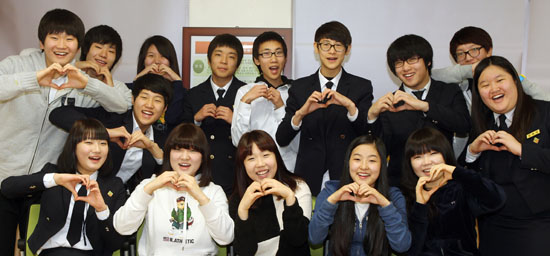School bullies watched by peers

Peer counselors at Bucheon Information Industry High School, who are trained to deal with quarrels or fights in an attempt to quell school violence, pose for a photo on Thursday at the school in Bucheon, Gyeonggi. By Byun Sun-goo
Late last month, two tenth grade girls at Bucheon Information Industry High School got into a quarrel, which threatened to turn violent.
Jeong Hyun-jin, 15, who is known as a “peer counselor” at her school, stepped in to calm the girls down.
“Let’s not fight,” she told them. “We’re going to be juniors soon. Let’s try to be role models.”
Jeong is one of 28 students who have been named peer counselors by the school. They were trained by experts on how to deal with quarrels or fights during the first semester last year and are now on the prowl looking for disturbances waiting to break out.
According to the school, peer counselors were able to simmer down at least 10 fights or quarrels in one semester.
After the tragic suicide of a bullied 13-year-old in Daegu Dec. 20, the entire nation is up in arms about violence in schools. The peer counselor program is an attempt to create a squad of first responders to violence in the schools among the students themselves.
The Gyeonggi Provincial Office of Education introduced the peer counselor system last year in 10 schools in the province. Peer counselors are students who received counseling lesson from experts hired by the education office, and they watch out for altercations and also make themselves available to their fellow students to discuss bullying that’s going on behind the scenes.
The Korea Youth Counseling Institute has been helping local governments adopt the system.
Education Minister Lee Ju-ho said last week that he will “expand the peer counselor program that has been operated by some schools to cover all elementary and middle schools across the country.”
Currently there are only 5,000 peer counselors.
“According to a study, at least four peer counselors are required per class for the program to be effective,” said Cho Eun-kyung, an official at the Korea Youth Counseling Institute.
At the very least, peer counselors are willing to confront students who resort to violence while other kids look away.
Experts say most students “remain as bystanders despite witnessing school violence” because they’re afraid of being accused of tattle-telling and becoming targets of bullies themselves.
According to a survey conducted by the Foundation for Preventing Youth Violence in 2010, 62 percent of students said they pretend they haven’t seen anything after witnessing instances of bullying.
“Most students remain as bystanders while feeling relief that they are not the victims,” said Cha Myung-ho, professor at the Graduate School of Education at Pyeongtaek Univeristy, “and some even join in the bullying to avoid being the victim.”
Experts suggest a change in peer culture and the peer counselor program could be a fundamental measure to tackle school violence as 51.1 percent of the students said they would talk to friends about bullying, according to the Foundation for Preventing Youth Violence.
By Yim Seung-hye, Chun In-sung [sharon@joongang.co.kr]










with the Korea JoongAng Daily
To write comments, please log in to one of the accounts.
Standards Board Policy (0/250자)